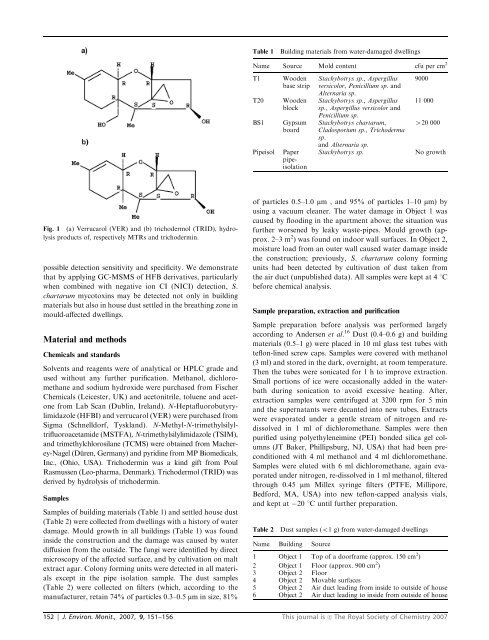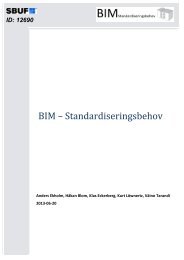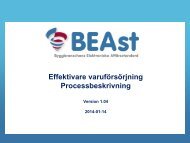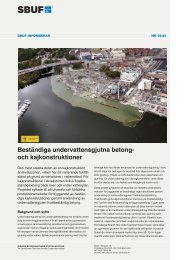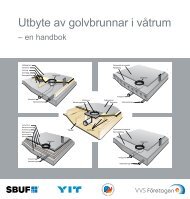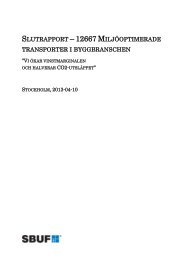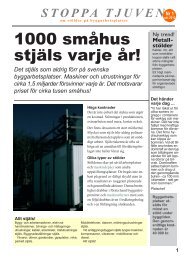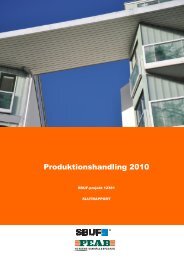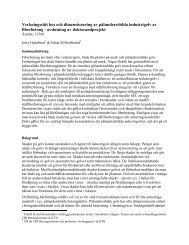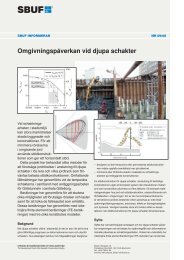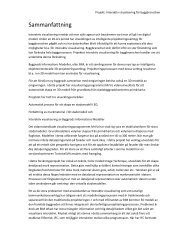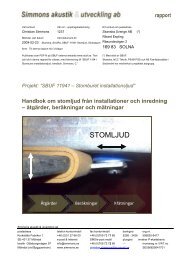Rapport SBUF-projekt: Mykotoxiner i inomhusmiljöer. Förekomst ...
Rapport SBUF-projekt: Mykotoxiner i inomhusmiljöer. Förekomst ...
Rapport SBUF-projekt: Mykotoxiner i inomhusmiljöer. Förekomst ...
Create successful ePaper yourself
Turn your PDF publications into a flip-book with our unique Google optimized e-Paper software.
Fig. 1 (a) Verrucarol (VER) and (b) trichodermol (TRID), hydrolysis<br />
products of, respectively MTRs and trichodermin.<br />
possible detection sensitivity and specificity. We demonstrate<br />
that by applying GC-MSMS of HFB derivatives, particularly<br />
when combined with negative ion CI (NICI) detection, S.<br />
chartarum mycotoxins may be detected not only in building<br />
materials but also in house dust settled in the breathing zone in<br />
mould-affected dwellings.<br />
Material and methods<br />
Chemicals and standards<br />
Solvents and reagents were of analytical or HPLC grade and<br />
used without any further purification. Methanol, dichloromethane<br />
and sodium hydroxide were purchased from Fischer<br />
Chemicals (Leicester, UK) and acetonitrile, toluene and acetone<br />
from Lab Scan (Dublin, Ireland). N-Heptafluorobutyrylimidazole<br />
(HFBI) and verrucarol (VER) were purchased from<br />
Sigma (Schnelldorf, Tyskland). N-Methyl-N-trimethylsilyltrifluoroacetamide<br />
(MSTFA), N-trimethylsilylimidazole (TSIM),<br />
and trimethylchlorosilane (TCMS) were obtained from Macherey-Nagel<br />
(Du¨ ren, Germany) and pyridine from MP Biomedicals,<br />
Inc., (Ohio, USA). Trichodermin was a kind gift from Poul<br />
Rasmussen (Leo-pharma, Denmark). Trichodermol (TRID) was<br />
derived by hydrolysis of trichodermin.<br />
Samples<br />
Samples of building materials (Table 1) and settled house dust<br />
(Table 2) were collected from dwellings with a history of water<br />
damage. Mould growth in all buildings (Table 1) was found<br />
inside the construction and the damage was caused by water<br />
diffusion from the outside. The fungi were identified by direct<br />
microscopy of the affected surface, and by cultivation on malt<br />
extract agar. Colony forming units were detected in all materials<br />
except in the pipe isolation sample. The dust samples<br />
(Table 2) were collected on filters (which, according to the<br />
manufacturer, retain 74% of particles 0.3–0.5 mm in size, 81%<br />
Table 1 Building materials from water-damaged dwellings<br />
Name Source Mold content cfu per cm 2<br />
T1 Wooden<br />
base strip<br />
T20 Wooden<br />
block<br />
BS1 Gypsum<br />
board<br />
Pipeisol Paper<br />
pipeisolation<br />
Stachybotrys sp., Aspergillus<br />
versicolor, Penicillium sp. and<br />
Alternaria sp.<br />
Stachybotrys sp., Aspergillus<br />
sp., Aspergillus versicolor and<br />
Penicillium sp.<br />
of particles 0.5–1.0 mm , and 95% of particles 1–10 mm) by<br />
using a vacuum cleaner. The water damage in Object 1 was<br />
caused by flooding in the apartment above; the situation was<br />
further worsened by leaky waste-pipes. Mould growth (approx.<br />
2–3 m 2 ) was found on indoor wall surfaces. In Object 2,<br />
moisture load from an outer wall caused water damage inside<br />
the construction; previously, S. chartarum colony forming<br />
units had been detected by cultivation of dust taken from<br />
the air duct (unpublished data). All samples were kept at 4 1C<br />
before chemical analysis.<br />
Sample preparation, extraction and purification<br />
9000<br />
11 000<br />
Stachybotrys chartarum, 420 000<br />
Cladosporium sp., Trichoderma<br />
sp.<br />
and Alternaria sp.<br />
Stachybotrys sp. No growth<br />
Sample preparation before analysis was performed largely<br />
according to Andersen et al. 16 Dust (0.4–0.6 g) and building<br />
materials (0.5–1 g) were placed in 10 ml glass test tubes with<br />
teflon-lined screw caps. Samples were covered with methanol<br />
(3 ml) and stored in the dark, overnight, at room temperature.<br />
Then the tubes were sonicated for 1 h to improve extraction.<br />
Small portions of ice were occasionally added in the waterbath<br />
during sonication to avoid excessive heating. After,<br />
extraction samples were centrifuged at 3200 rpm for 5 min<br />
and the supernatants were decanted into new tubes. Extracts<br />
were evaporated under a gentle stream of nitrogen and redissolved<br />
in 1 ml of dichloromethane. Samples were then<br />
purified using polyethyleneimine (PEI) bonded silica gel columns<br />
(JT Baker, Phillipsburg, NJ, USA) that had been preconditioned<br />
with 4 ml methanol and 4 ml dichloromethane.<br />
Samples were eluted with 6 ml dichloromethane, again evaporated<br />
under nitrogen, re-dissolved in 1 ml methanol, filtered<br />
through 0.45 mm Millex syringe filters (PTFE, Millipore,<br />
Bedford, MA, USA) into new teflon-capped analysis vials,<br />
and kept at 20 1C until further preparation.<br />
Table 2 Dust samples (o1 g) from water-damaged dwellings<br />
Name Building Source<br />
1 Object 1 Top of a doorframe (approx. 150 cm 2 )<br />
2 Object 1 Floor (approx. 900 cm 2 )<br />
3 Object 2 Floor<br />
4 Object 2 Movable surfaces<br />
5 Object 2 Air duct leading from inside to outside of house<br />
6 Object 2 Air duct leading to inside from outside of house<br />
152 | J. Environ. Monit., 2007, 9, 151–156 This journal is c The Royal Society of Chemistry 2007


